Organizational Behaviour Report: Culture, Power, Motivation & Teamwork
VerifiedAdded on 2023/03/24
|14
|3944
|49
Report
AI Summary
This report provides an overview of organizational behaviour, examining how organizational culture, policies, and power influence individual and team performance. It delves into content and process theories of motivation, such as Maslow's hierarchy of needs and the ERG theory, explaining how motivation techniques enable effective achievement of organizational goals. The report also differentiates between effective and ineffective teams, highlighting key characteristics such as open communication, shared goals, and constructive conflict resolution. Furthermore, it touches upon the core concepts and philosophies of organizational behaviour, emphasizing the importance of understanding and managing individual behaviour within an organizational context to enhance overall productivity and employee satisfaction. The analysis includes the impact of office politics, power dynamics, and the role of fairness and equity in motivating employees.
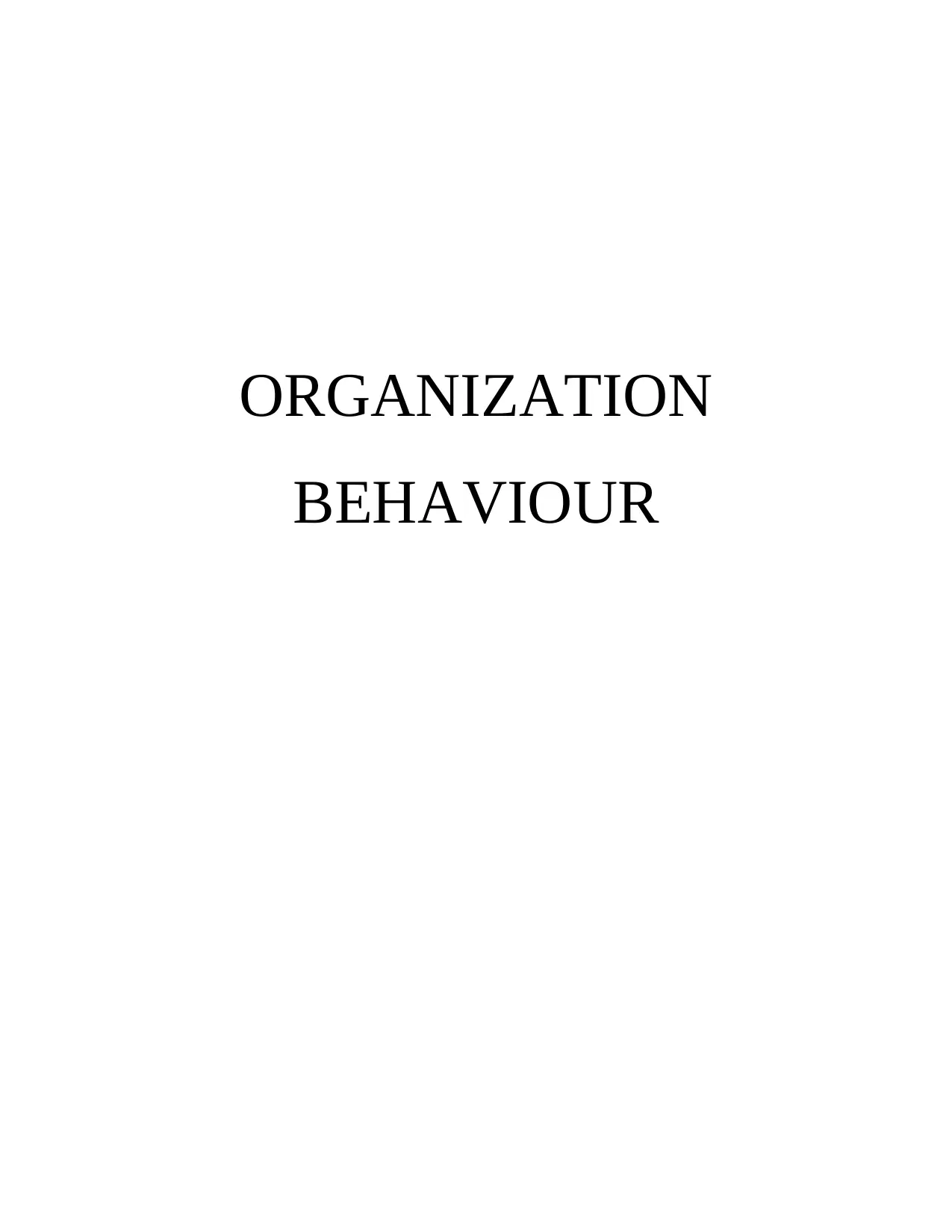
ORGANIZATION
BEHAVIOUR
BEHAVIOUR
Paraphrase This Document
Need a fresh take? Get an instant paraphrase of this document with our AI Paraphraser
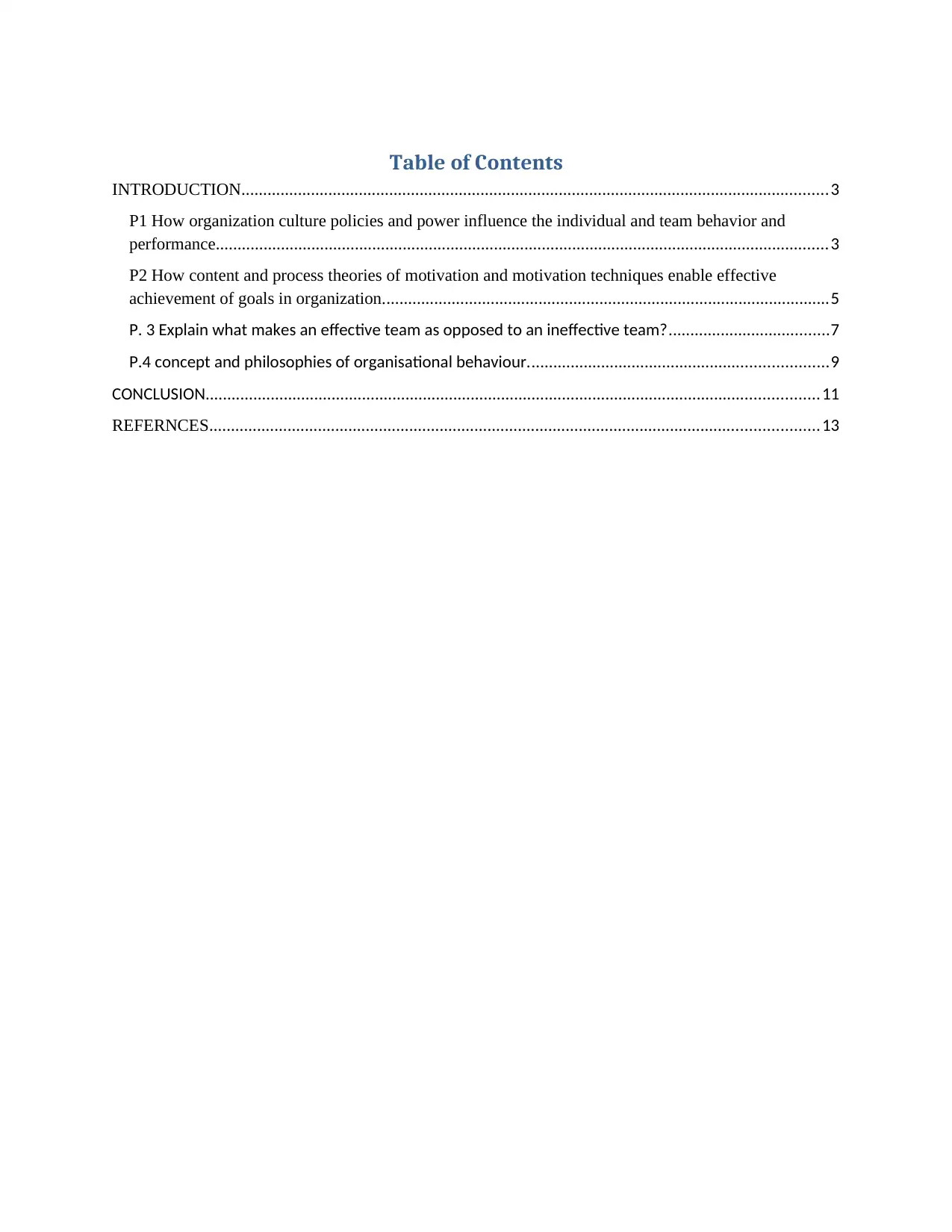
Table of Contents
INTRODUCTION.......................................................................................................................................3
P1 How organization culture policies and power influence the individual and team behavior and
performance.............................................................................................................................................3
P2 How content and process theories of motivation and motivation techniques enable effective
achievement of goals in organization.......................................................................................................5
P. 3 Explain what makes an effective team as opposed to an ineffective team?.....................................7
P.4 concept and philosophies of organisational behaviour.....................................................................9
CONCLUSION.............................................................................................................................................11
REFERNCES............................................................................................................................................13
INTRODUCTION.......................................................................................................................................3
P1 How organization culture policies and power influence the individual and team behavior and
performance.............................................................................................................................................3
P2 How content and process theories of motivation and motivation techniques enable effective
achievement of goals in organization.......................................................................................................5
P. 3 Explain what makes an effective team as opposed to an ineffective team?.....................................7
P.4 concept and philosophies of organisational behaviour.....................................................................9
CONCLUSION.............................................................................................................................................11
REFERNCES............................................................................................................................................13
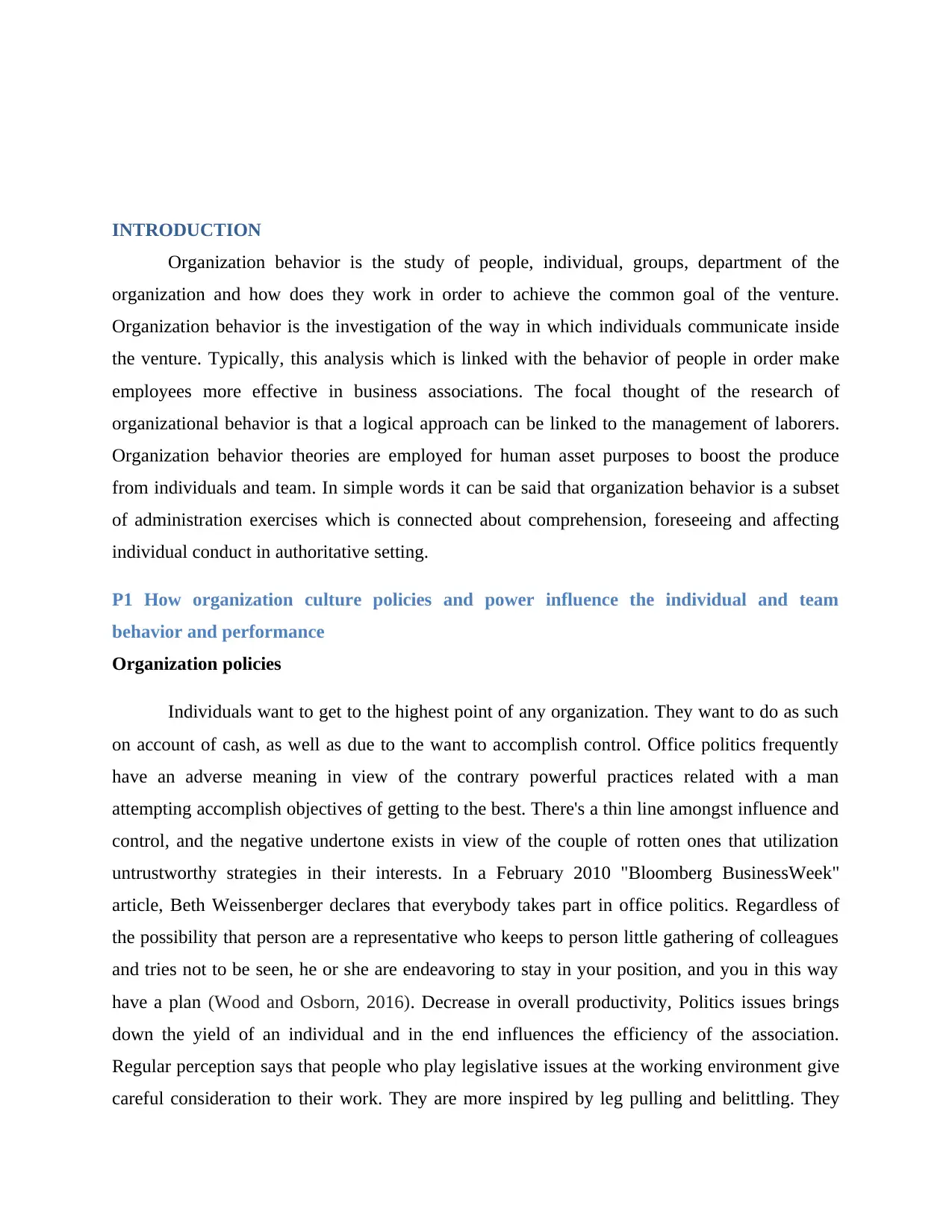
INTRODUCTION
Organization behavior is the study of people, individual, groups, department of the
organization and how does they work in order to achieve the common goal of the venture.
Organization behavior is the investigation of the way in which individuals communicate inside
the venture. Typically, this analysis which is linked with the behavior of people in order make
employees more effective in business associations. The focal thought of the research of
organizational behavior is that a logical approach can be linked to the management of laborers.
Organization behavior theories are employed for human asset purposes to boost the produce
from individuals and team. In simple words it can be said that organization behavior is a subset
of administration exercises which is connected about comprehension, foreseeing and affecting
individual conduct in authoritative setting.
P1 How organization culture policies and power influence the individual and team
behavior and performance
Organization policies
Individuals want to get to the highest point of any organization. They want to do as such
on account of cash, as well as due to the want to accomplish control. Office politics frequently
have an adverse meaning in view of the contrary powerful practices related with a man
attempting accomplish objectives of getting to the best. There's a thin line amongst influence and
control, and the negative undertone exists in view of the couple of rotten ones that utilization
untrustworthy strategies in their interests. In a February 2010 "Bloomberg BusinessWeek"
article, Beth Weissenberger declares that everybody takes part in office politics. Regardless of
the possibility that person are a representative who keeps to person little gathering of colleagues
and tries not to be seen, he or she are endeavoring to stay in your position, and you in this way
have a plan (Wood and Osborn, 2016). Decrease in overall productivity, Politics issues brings
down the yield of an individual and in the end influences the efficiency of the association.
Regular perception says that people who play legislative issues at the working environment give
careful consideration to their work. They are more inspired by leg pulling and belittling. They
Organization behavior is the study of people, individual, groups, department of the
organization and how does they work in order to achieve the common goal of the venture.
Organization behavior is the investigation of the way in which individuals communicate inside
the venture. Typically, this analysis which is linked with the behavior of people in order make
employees more effective in business associations. The focal thought of the research of
organizational behavior is that a logical approach can be linked to the management of laborers.
Organization behavior theories are employed for human asset purposes to boost the produce
from individuals and team. In simple words it can be said that organization behavior is a subset
of administration exercises which is connected about comprehension, foreseeing and affecting
individual conduct in authoritative setting.
P1 How organization culture policies and power influence the individual and team
behavior and performance
Organization policies
Individuals want to get to the highest point of any organization. They want to do as such
on account of cash, as well as due to the want to accomplish control. Office politics frequently
have an adverse meaning in view of the contrary powerful practices related with a man
attempting accomplish objectives of getting to the best. There's a thin line amongst influence and
control, and the negative undertone exists in view of the couple of rotten ones that utilization
untrustworthy strategies in their interests. In a February 2010 "Bloomberg BusinessWeek"
article, Beth Weissenberger declares that everybody takes part in office politics. Regardless of
the possibility that person are a representative who keeps to person little gathering of colleagues
and tries not to be seen, he or she are endeavoring to stay in your position, and you in this way
have a plan (Wood and Osborn, 2016). Decrease in overall productivity, Politics issues brings
down the yield of an individual and in the end influences the efficiency of the association.
Regular perception says that people who play legislative issues at the working environment give
careful consideration to their work. They are more inspired by leg pulling and belittling. They
⊘ This is a preview!⊘
Do you want full access?
Subscribe today to unlock all pages.

Trusted by 1+ million students worldwide
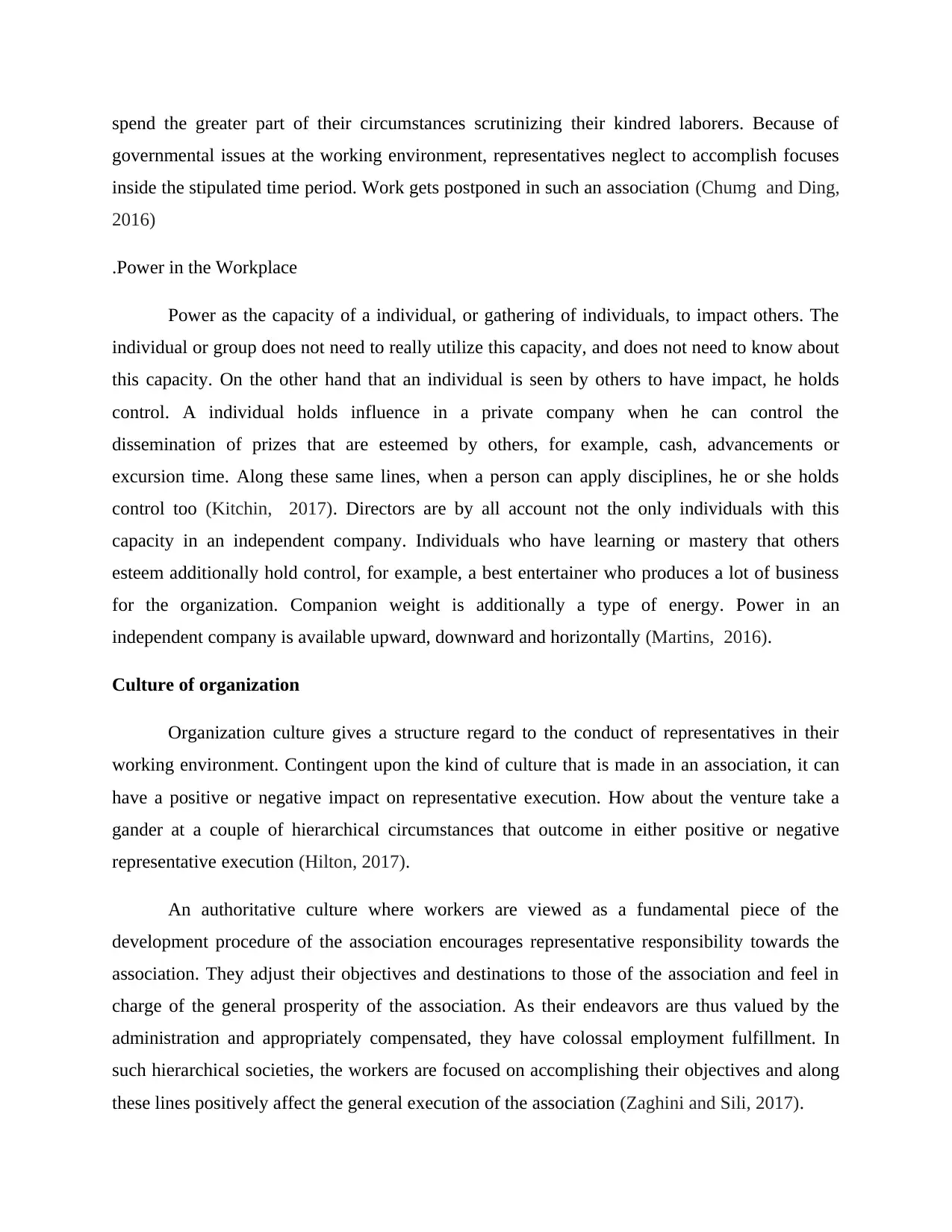
spend the greater part of their circumstances scrutinizing their kindred laborers. Because of
governmental issues at the working environment, representatives neglect to accomplish focuses
inside the stipulated time period. Work gets postponed in such an association (Chumg and Ding,
2016)
.Power in the Workplace
Power as the capacity of a individual, or gathering of individuals, to impact others. The
individual or group does not need to really utilize this capacity, and does not need to know about
this capacity. On the other hand that an individual is seen by others to have impact, he holds
control. A individual holds influence in a private company when he can control the
dissemination of prizes that are esteemed by others, for example, cash, advancements or
excursion time. Along these same lines, when a person can apply disciplines, he or she holds
control too (Kitchin, 2017). Directors are by all account not the only individuals with this
capacity in an independent company. Individuals who have learning or mastery that others
esteem additionally hold control, for example, a best entertainer who produces a lot of business
for the organization. Companion weight is additionally a type of energy. Power in an
independent company is available upward, downward and horizontally (Martins, 2016).
Culture of organization
Organization culture gives a structure regard to the conduct of representatives in their
working environment. Contingent upon the kind of culture that is made in an association, it can
have a positive or negative impact on representative execution. How about the venture take a
gander at a couple of hierarchical circumstances that outcome in either positive or negative
representative execution (Hilton, 2017).
An authoritative culture where workers are viewed as a fundamental piece of the
development procedure of the association encourages representative responsibility towards the
association. They adjust their objectives and destinations to those of the association and feel in
charge of the general prosperity of the association. As their endeavors are thus valued by the
administration and appropriately compensated, they have colossal employment fulfillment. In
such hierarchical societies, the workers are focused on accomplishing their objectives and along
these lines positively affect the general execution of the association (Zaghini and Sili, 2017).
governmental issues at the working environment, representatives neglect to accomplish focuses
inside the stipulated time period. Work gets postponed in such an association (Chumg and Ding,
2016)
.Power in the Workplace
Power as the capacity of a individual, or gathering of individuals, to impact others. The
individual or group does not need to really utilize this capacity, and does not need to know about
this capacity. On the other hand that an individual is seen by others to have impact, he holds
control. A individual holds influence in a private company when he can control the
dissemination of prizes that are esteemed by others, for example, cash, advancements or
excursion time. Along these same lines, when a person can apply disciplines, he or she holds
control too (Kitchin, 2017). Directors are by all account not the only individuals with this
capacity in an independent company. Individuals who have learning or mastery that others
esteem additionally hold control, for example, a best entertainer who produces a lot of business
for the organization. Companion weight is additionally a type of energy. Power in an
independent company is available upward, downward and horizontally (Martins, 2016).
Culture of organization
Organization culture gives a structure regard to the conduct of representatives in their
working environment. Contingent upon the kind of culture that is made in an association, it can
have a positive or negative impact on representative execution. How about the venture take a
gander at a couple of hierarchical circumstances that outcome in either positive or negative
representative execution (Hilton, 2017).
An authoritative culture where workers are viewed as a fundamental piece of the
development procedure of the association encourages representative responsibility towards the
association. They adjust their objectives and destinations to those of the association and feel in
charge of the general prosperity of the association. As their endeavors are thus valued by the
administration and appropriately compensated, they have colossal employment fulfillment. In
such hierarchical societies, the workers are focused on accomplishing their objectives and along
these lines positively affect the general execution of the association (Zaghini and Sili, 2017).
Paraphrase This Document
Need a fresh take? Get an instant paraphrase of this document with our AI Paraphraser
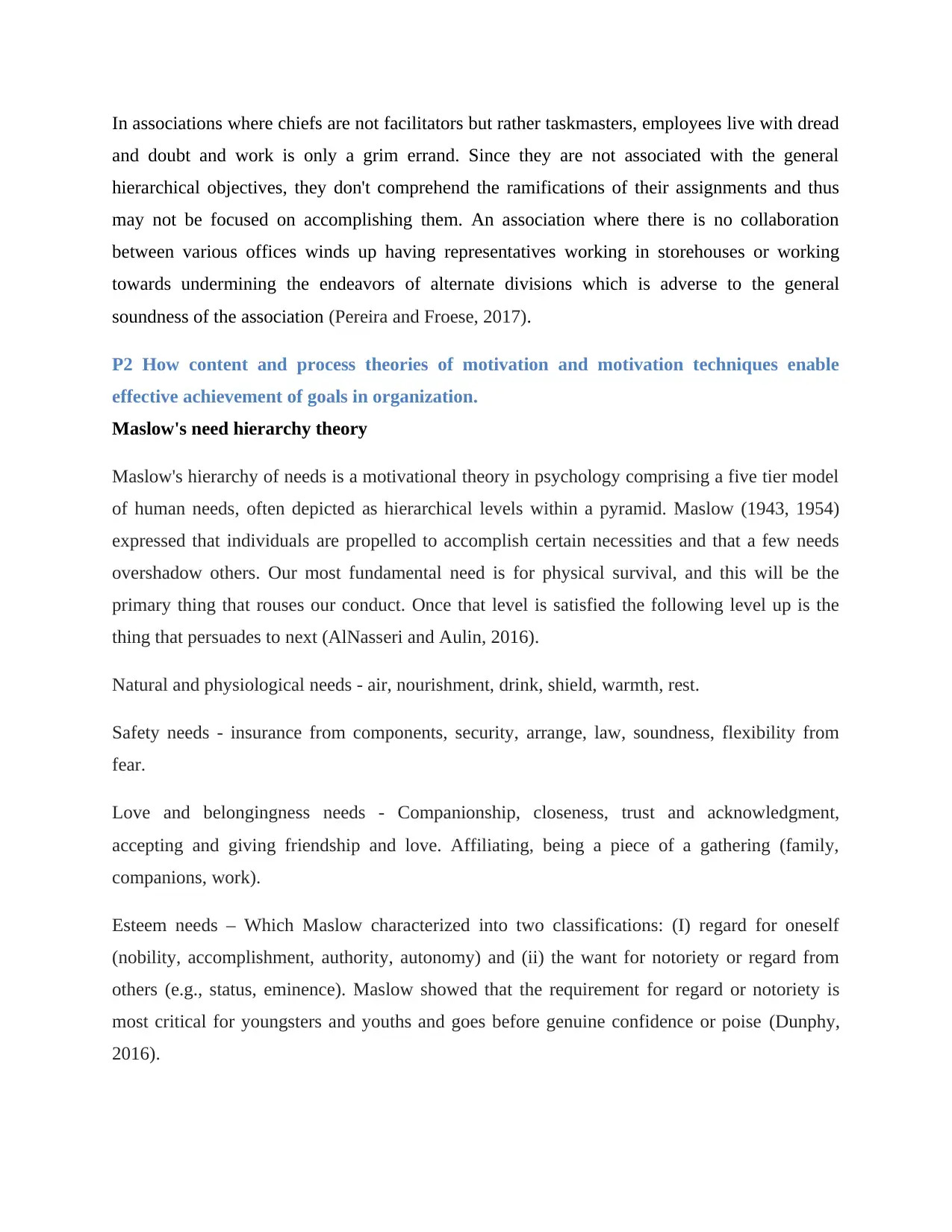
In associations where chiefs are not facilitators but rather taskmasters, employees live with dread
and doubt and work is only a grim errand. Since they are not associated with the general
hierarchical objectives, they don't comprehend the ramifications of their assignments and thus
may not be focused on accomplishing them. An association where there is no collaboration
between various offices winds up having representatives working in storehouses or working
towards undermining the endeavors of alternate divisions which is adverse to the general
soundness of the association (Pereira and Froese, 2017).
P2 How content and process theories of motivation and motivation techniques enable
effective achievement of goals in organization.
Maslow's need hierarchy theory
Maslow's hierarchy of needs is a motivational theory in psychology comprising a five tier model
of human needs, often depicted as hierarchical levels within a pyramid. Maslow (1943, 1954)
expressed that individuals are propelled to accomplish certain necessities and that a few needs
overshadow others. Our most fundamental need is for physical survival, and this will be the
primary thing that rouses our conduct. Once that level is satisfied the following level up is the
thing that persuades to next (AlNasseri and Aulin, 2016).
Natural and physiological needs - air, nourishment, drink, shield, warmth, rest.
Safety needs - insurance from components, security, arrange, law, soundness, flexibility from
fear.
Love and belongingness needs - Companionship, closeness, trust and acknowledgment,
accepting and giving friendship and love. Affiliating, being a piece of a gathering (family,
companions, work).
Esteem needs – Which Maslow characterized into two classifications: (I) regard for oneself
(nobility, accomplishment, authority, autonomy) and (ii) the want for notoriety or regard from
others (e.g., status, eminence). Maslow showed that the requirement for regard or notoriety is
most critical for youngsters and youths and goes before genuine confidence or poise (Dunphy,
2016).
and doubt and work is only a grim errand. Since they are not associated with the general
hierarchical objectives, they don't comprehend the ramifications of their assignments and thus
may not be focused on accomplishing them. An association where there is no collaboration
between various offices winds up having representatives working in storehouses or working
towards undermining the endeavors of alternate divisions which is adverse to the general
soundness of the association (Pereira and Froese, 2017).
P2 How content and process theories of motivation and motivation techniques enable
effective achievement of goals in organization.
Maslow's need hierarchy theory
Maslow's hierarchy of needs is a motivational theory in psychology comprising a five tier model
of human needs, often depicted as hierarchical levels within a pyramid. Maslow (1943, 1954)
expressed that individuals are propelled to accomplish certain necessities and that a few needs
overshadow others. Our most fundamental need is for physical survival, and this will be the
primary thing that rouses our conduct. Once that level is satisfied the following level up is the
thing that persuades to next (AlNasseri and Aulin, 2016).
Natural and physiological needs - air, nourishment, drink, shield, warmth, rest.
Safety needs - insurance from components, security, arrange, law, soundness, flexibility from
fear.
Love and belongingness needs - Companionship, closeness, trust and acknowledgment,
accepting and giving friendship and love. Affiliating, being a piece of a gathering (family,
companions, work).
Esteem needs – Which Maslow characterized into two classifications: (I) regard for oneself
(nobility, accomplishment, authority, autonomy) and (ii) the want for notoriety or regard from
others (e.g., status, eminence). Maslow showed that the requirement for regard or notoriety is
most critical for youngsters and youths and goes before genuine confidence or poise (Dunphy,
2016).
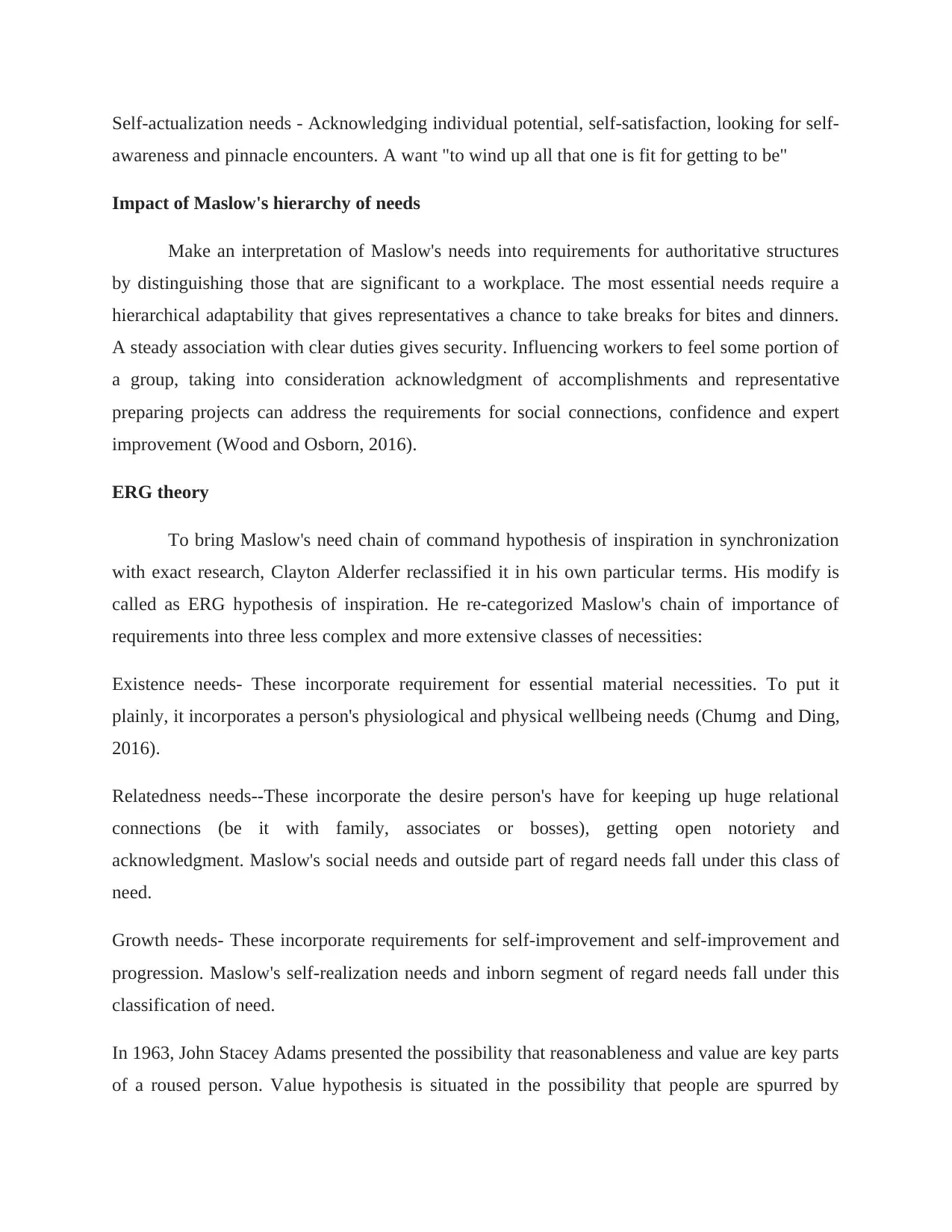
Self-actualization needs - Acknowledging individual potential, self-satisfaction, looking for self-
awareness and pinnacle encounters. A want "to wind up all that one is fit for getting to be"
Impact of Maslow's hierarchy of needs
Make an interpretation of Maslow's needs into requirements for authoritative structures
by distinguishing those that are significant to a workplace. The most essential needs require a
hierarchical adaptability that gives representatives a chance to take breaks for bites and dinners.
A steady association with clear duties gives security. Influencing workers to feel some portion of
a group, taking into consideration acknowledgment of accomplishments and representative
preparing projects can address the requirements for social connections, confidence and expert
improvement (Wood and Osborn, 2016).
ERG theory
To bring Maslow's need chain of command hypothesis of inspiration in synchronization
with exact research, Clayton Alderfer reclassified it in his own particular terms. His modify is
called as ERG hypothesis of inspiration. He re-categorized Maslow's chain of importance of
requirements into three less complex and more extensive classes of necessities:
Existence needs- These incorporate requirement for essential material necessities. To put it
plainly, it incorporates a person's physiological and physical wellbeing needs (Chumg and Ding,
2016).
Relatedness needs--These incorporate the desire person's have for keeping up huge relational
connections (be it with family, associates or bosses), getting open notoriety and
acknowledgment. Maslow's social needs and outside part of regard needs fall under this class of
need.
Growth needs- These incorporate requirements for self-improvement and self-improvement and
progression. Maslow's self-realization needs and inborn segment of regard needs fall under this
classification of need.
In 1963, John Stacey Adams presented the possibility that reasonableness and value are key parts
of a roused person. Value hypothesis is situated in the possibility that people are spurred by
awareness and pinnacle encounters. A want "to wind up all that one is fit for getting to be"
Impact of Maslow's hierarchy of needs
Make an interpretation of Maslow's needs into requirements for authoritative structures
by distinguishing those that are significant to a workplace. The most essential needs require a
hierarchical adaptability that gives representatives a chance to take breaks for bites and dinners.
A steady association with clear duties gives security. Influencing workers to feel some portion of
a group, taking into consideration acknowledgment of accomplishments and representative
preparing projects can address the requirements for social connections, confidence and expert
improvement (Wood and Osborn, 2016).
ERG theory
To bring Maslow's need chain of command hypothesis of inspiration in synchronization
with exact research, Clayton Alderfer reclassified it in his own particular terms. His modify is
called as ERG hypothesis of inspiration. He re-categorized Maslow's chain of importance of
requirements into three less complex and more extensive classes of necessities:
Existence needs- These incorporate requirement for essential material necessities. To put it
plainly, it incorporates a person's physiological and physical wellbeing needs (Chumg and Ding,
2016).
Relatedness needs--These incorporate the desire person's have for keeping up huge relational
connections (be it with family, associates or bosses), getting open notoriety and
acknowledgment. Maslow's social needs and outside part of regard needs fall under this class of
need.
Growth needs- These incorporate requirements for self-improvement and self-improvement and
progression. Maslow's self-realization needs and inborn segment of regard needs fall under this
classification of need.
In 1963, John Stacey Adams presented the possibility that reasonableness and value are key parts
of a roused person. Value hypothesis is situated in the possibility that people are spurred by
⊘ This is a preview!⊘
Do you want full access?
Subscribe today to unlock all pages.

Trusted by 1+ million students worldwide
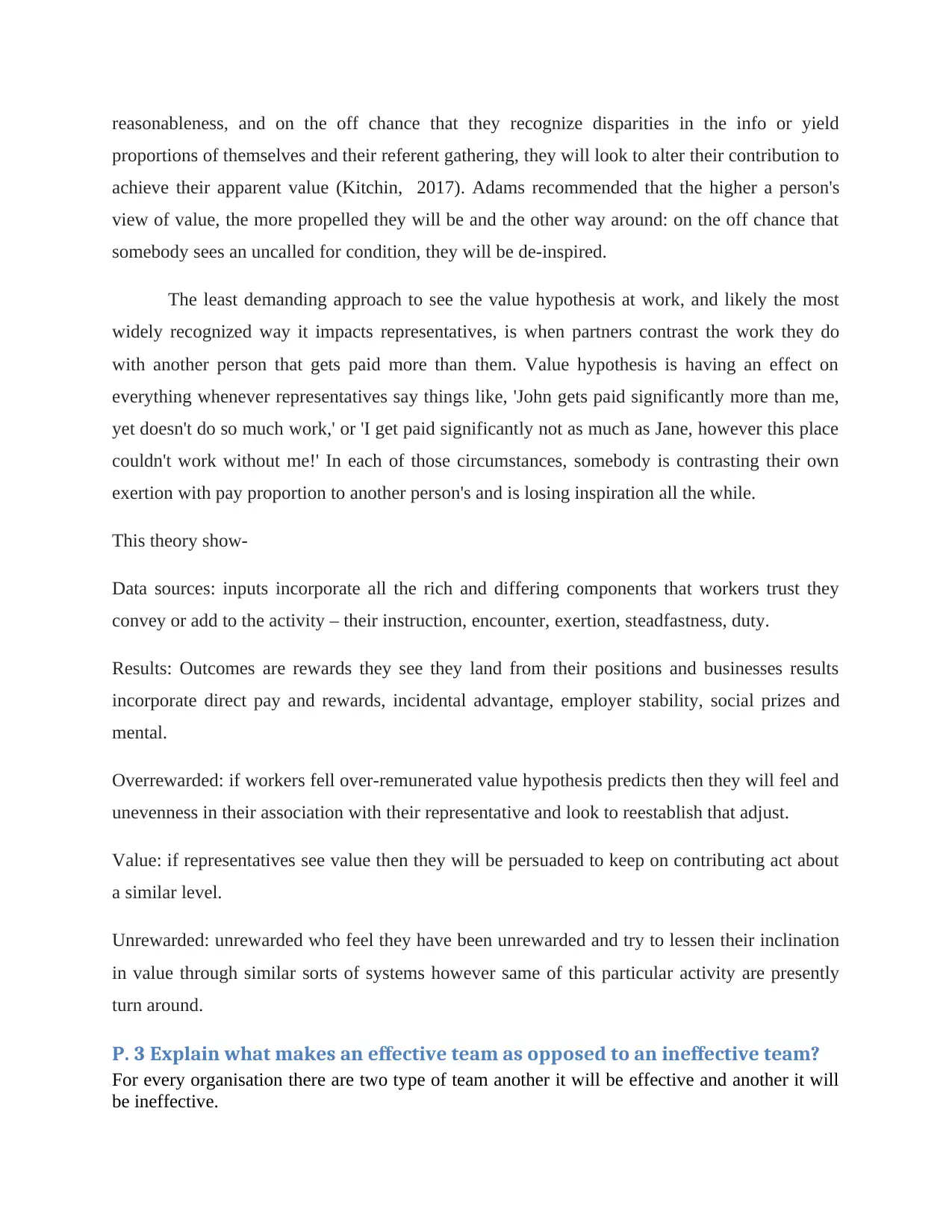
reasonableness, and on the off chance that they recognize disparities in the info or yield
proportions of themselves and their referent gathering, they will look to alter their contribution to
achieve their apparent value (Kitchin, 2017). Adams recommended that the higher a person's
view of value, the more propelled they will be and the other way around: on the off chance that
somebody sees an uncalled for condition, they will be de-inspired.
The least demanding approach to see the value hypothesis at work, and likely the most
widely recognized way it impacts representatives, is when partners contrast the work they do
with another person that gets paid more than them. Value hypothesis is having an effect on
everything whenever representatives say things like, 'John gets paid significantly more than me,
yet doesn't do so much work,' or 'I get paid significantly not as much as Jane, however this place
couldn't work without me!' In each of those circumstances, somebody is contrasting their own
exertion with pay proportion to another person's and is losing inspiration all the while.
This theory show-
Data sources: inputs incorporate all the rich and differing components that workers trust they
convey or add to the activity – their instruction, encounter, exertion, steadfastness, duty.
Results: Outcomes are rewards they see they land from their positions and businesses results
incorporate direct pay and rewards, incidental advantage, employer stability, social prizes and
mental.
Overrewarded: if workers fell over-remunerated value hypothesis predicts then they will feel and
unevenness in their association with their representative and look to reestablish that adjust.
Value: if representatives see value then they will be persuaded to keep on contributing act about
a similar level.
Unrewarded: unrewarded who feel they have been unrewarded and try to lessen their inclination
in value through similar sorts of systems however same of this particular activity are presently
turn around.
P. 3 Explain what makes an effective team as opposed to an ineffective team?
For every organisation there are two type of team another it will be effective and another it will
be ineffective.
proportions of themselves and their referent gathering, they will look to alter their contribution to
achieve their apparent value (Kitchin, 2017). Adams recommended that the higher a person's
view of value, the more propelled they will be and the other way around: on the off chance that
somebody sees an uncalled for condition, they will be de-inspired.
The least demanding approach to see the value hypothesis at work, and likely the most
widely recognized way it impacts representatives, is when partners contrast the work they do
with another person that gets paid more than them. Value hypothesis is having an effect on
everything whenever representatives say things like, 'John gets paid significantly more than me,
yet doesn't do so much work,' or 'I get paid significantly not as much as Jane, however this place
couldn't work without me!' In each of those circumstances, somebody is contrasting their own
exertion with pay proportion to another person's and is losing inspiration all the while.
This theory show-
Data sources: inputs incorporate all the rich and differing components that workers trust they
convey or add to the activity – their instruction, encounter, exertion, steadfastness, duty.
Results: Outcomes are rewards they see they land from their positions and businesses results
incorporate direct pay and rewards, incidental advantage, employer stability, social prizes and
mental.
Overrewarded: if workers fell over-remunerated value hypothesis predicts then they will feel and
unevenness in their association with their representative and look to reestablish that adjust.
Value: if representatives see value then they will be persuaded to keep on contributing act about
a similar level.
Unrewarded: unrewarded who feel they have been unrewarded and try to lessen their inclination
in value through similar sorts of systems however same of this particular activity are presently
turn around.
P. 3 Explain what makes an effective team as opposed to an ineffective team?
For every organisation there are two type of team another it will be effective and another it will
be ineffective.
Paraphrase This Document
Need a fresh take? Get an instant paraphrase of this document with our AI Paraphraser
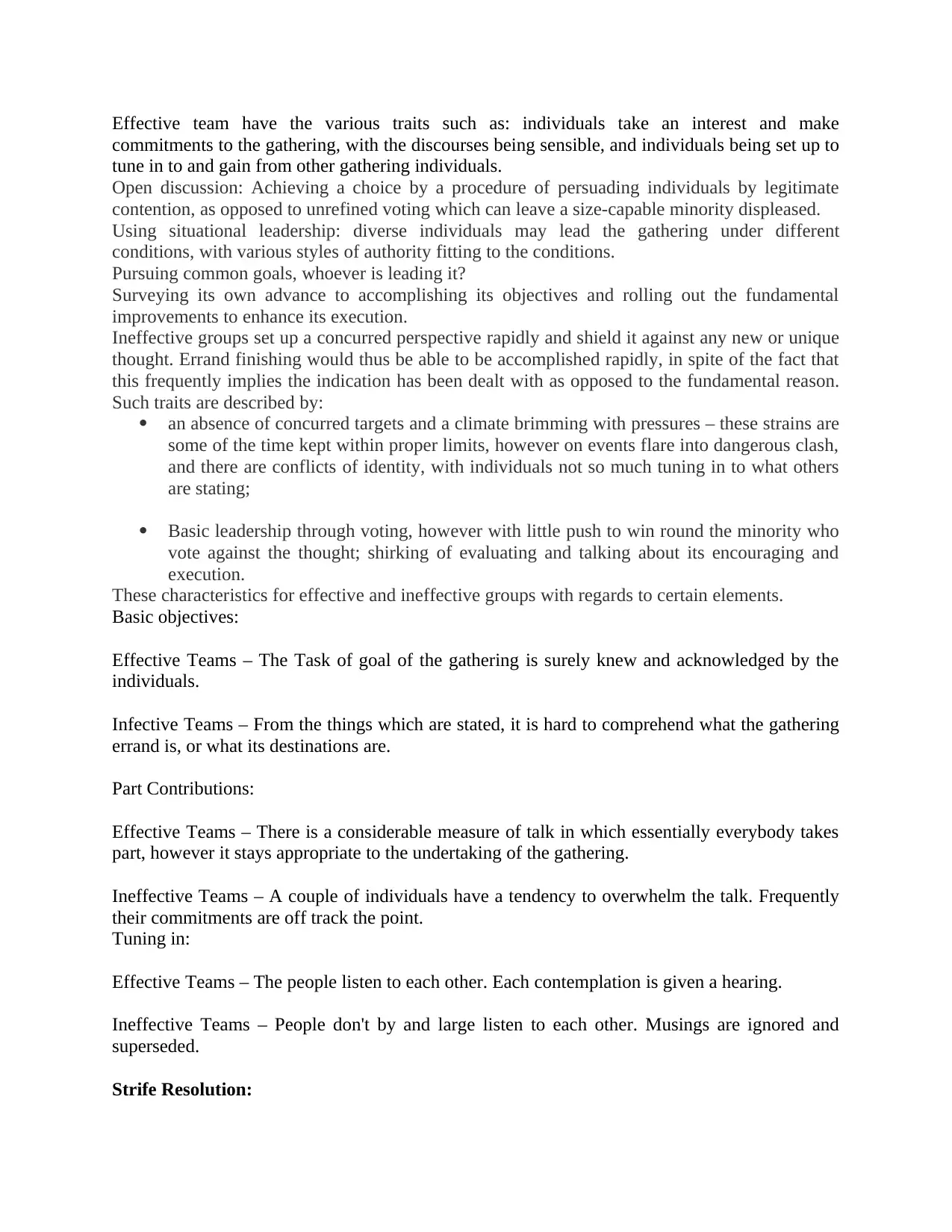
Effective team have the various traits such as: individuals take an interest and make
commitments to the gathering, with the discourses being sensible, and individuals being set up to
tune in to and gain from other gathering individuals.
Open discussion: Achieving a choice by a procedure of persuading individuals by legitimate
contention, as opposed to unrefined voting which can leave a size-capable minority displeased.
Using situational leadership: diverse individuals may lead the gathering under different
conditions, with various styles of authority fitting to the conditions.
Pursuing common goals, whoever is leading it?
Surveying its own advance to accomplishing its objectives and rolling out the fundamental
improvements to enhance its execution.
Ineffective groups set up a concurred perspective rapidly and shield it against any new or unique
thought. Errand finishing would thus be able to be accomplished rapidly, in spite of the fact that
this frequently implies the indication has been dealt with as opposed to the fundamental reason.
Such traits are described by:
an absence of concurred targets and a climate brimming with pressures – these strains are
some of the time kept within proper limits, however on events flare into dangerous clash,
and there are conflicts of identity, with individuals not so much tuning in to what others
are stating;
Basic leadership through voting, however with little push to win round the minority who
vote against the thought; shirking of evaluating and talking about its encouraging and
execution.
These characteristics for effective and ineffective groups with regards to certain elements.
Basic objectives:
Effective Teams – The Task of goal of the gathering is surely knew and acknowledged by the
individuals.
Infective Teams – From the things which are stated, it is hard to comprehend what the gathering
errand is, or what its destinations are.
Part Contributions:
Effective Teams – There is a considerable measure of talk in which essentially everybody takes
part, however it stays appropriate to the undertaking of the gathering.
Ineffective Teams – A couple of individuals have a tendency to overwhelm the talk. Frequently
their commitments are off track the point.
Tuning in:
Effective Teams – The people listen to each other. Each contemplation is given a hearing.
Ineffective Teams – People don't by and large listen to each other. Musings are ignored and
superseded.
Strife Resolution:
commitments to the gathering, with the discourses being sensible, and individuals being set up to
tune in to and gain from other gathering individuals.
Open discussion: Achieving a choice by a procedure of persuading individuals by legitimate
contention, as opposed to unrefined voting which can leave a size-capable minority displeased.
Using situational leadership: diverse individuals may lead the gathering under different
conditions, with various styles of authority fitting to the conditions.
Pursuing common goals, whoever is leading it?
Surveying its own advance to accomplishing its objectives and rolling out the fundamental
improvements to enhance its execution.
Ineffective groups set up a concurred perspective rapidly and shield it against any new or unique
thought. Errand finishing would thus be able to be accomplished rapidly, in spite of the fact that
this frequently implies the indication has been dealt with as opposed to the fundamental reason.
Such traits are described by:
an absence of concurred targets and a climate brimming with pressures – these strains are
some of the time kept within proper limits, however on events flare into dangerous clash,
and there are conflicts of identity, with individuals not so much tuning in to what others
are stating;
Basic leadership through voting, however with little push to win round the minority who
vote against the thought; shirking of evaluating and talking about its encouraging and
execution.
These characteristics for effective and ineffective groups with regards to certain elements.
Basic objectives:
Effective Teams – The Task of goal of the gathering is surely knew and acknowledged by the
individuals.
Infective Teams – From the things which are stated, it is hard to comprehend what the gathering
errand is, or what its destinations are.
Part Contributions:
Effective Teams – There is a considerable measure of talk in which essentially everybody takes
part, however it stays appropriate to the undertaking of the gathering.
Ineffective Teams – A couple of individuals have a tendency to overwhelm the talk. Frequently
their commitments are off track the point.
Tuning in:
Effective Teams – The people listen to each other. Each contemplation is given a hearing.
Ineffective Teams – People don't by and large listen to each other. Musings are ignored and
superseded.
Strife Resolution:
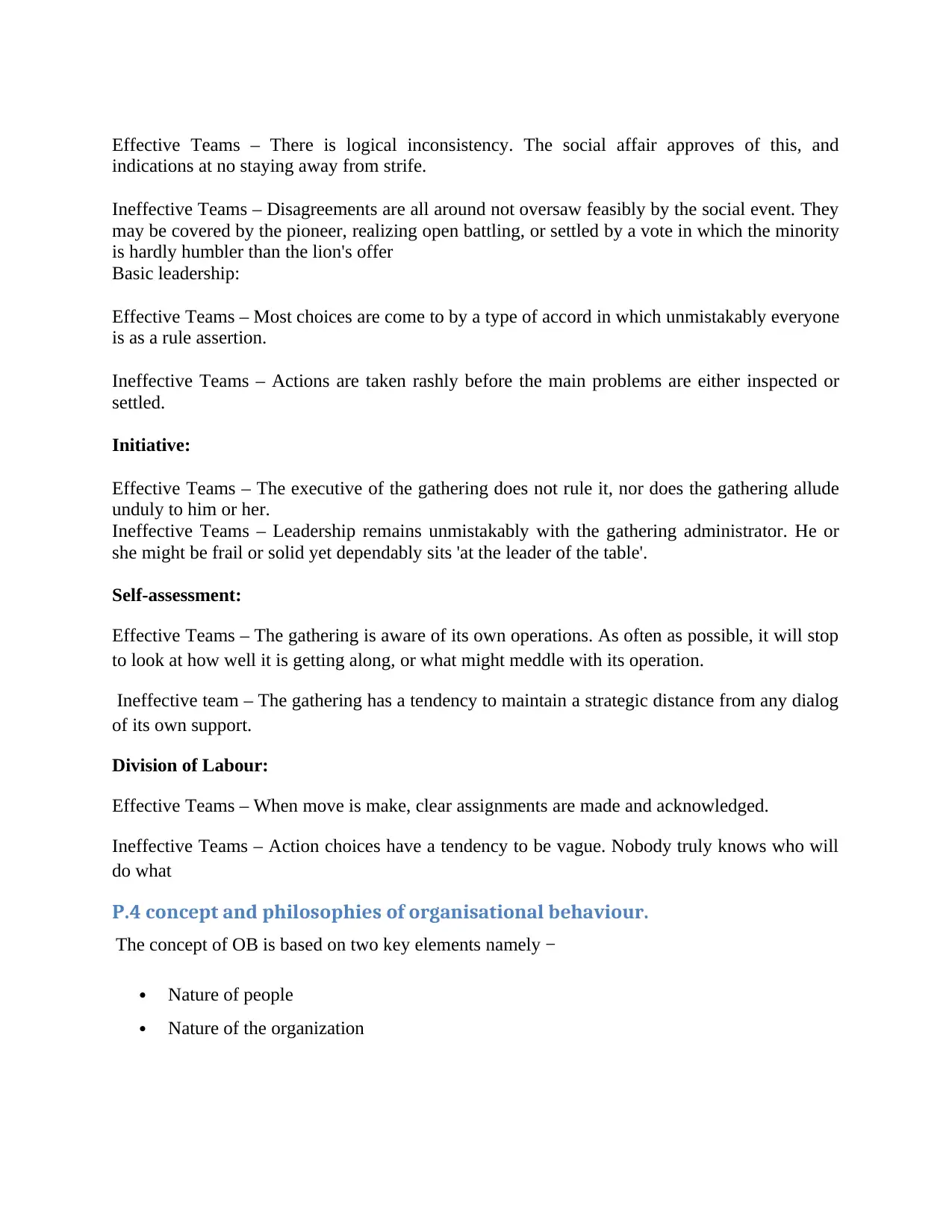
Effective Teams – There is logical inconsistency. The social affair approves of this, and
indications at no staying away from strife.
Ineffective Teams – Disagreements are all around not oversaw feasibly by the social event. They
may be covered by the pioneer, realizing open battling, or settled by a vote in which the minority
is hardly humbler than the lion's offer
Basic leadership:
Effective Teams – Most choices are come to by a type of accord in which unmistakably everyone
is as a rule assertion.
Ineffective Teams – Actions are taken rashly before the main problems are either inspected or
settled.
Initiative:
Effective Teams – The executive of the gathering does not rule it, nor does the gathering allude
unduly to him or her.
Ineffective Teams – Leadership remains unmistakably with the gathering administrator. He or
she might be frail or solid yet dependably sits 'at the leader of the table'.
Self-assessment:
Effective Teams – The gathering is aware of its own operations. As often as possible, it will stop
to look at how well it is getting along, or what might meddle with its operation.
Ineffective team – The gathering has a tendency to maintain a strategic distance from any dialog
of its own support.
Division of Labour:
Effective Teams – When move is make, clear assignments are made and acknowledged.
Ineffective Teams – Action choices have a tendency to be vague. Nobody truly knows who will
do what
P.4 concept and philosophies of organisational behaviour.
The concept of OB is based on two key elements namely −
Nature of people
Nature of the organization
indications at no staying away from strife.
Ineffective Teams – Disagreements are all around not oversaw feasibly by the social event. They
may be covered by the pioneer, realizing open battling, or settled by a vote in which the minority
is hardly humbler than the lion's offer
Basic leadership:
Effective Teams – Most choices are come to by a type of accord in which unmistakably everyone
is as a rule assertion.
Ineffective Teams – Actions are taken rashly before the main problems are either inspected or
settled.
Initiative:
Effective Teams – The executive of the gathering does not rule it, nor does the gathering allude
unduly to him or her.
Ineffective Teams – Leadership remains unmistakably with the gathering administrator. He or
she might be frail or solid yet dependably sits 'at the leader of the table'.
Self-assessment:
Effective Teams – The gathering is aware of its own operations. As often as possible, it will stop
to look at how well it is getting along, or what might meddle with its operation.
Ineffective team – The gathering has a tendency to maintain a strategic distance from any dialog
of its own support.
Division of Labour:
Effective Teams – When move is make, clear assignments are made and acknowledged.
Ineffective Teams – Action choices have a tendency to be vague. Nobody truly knows who will
do what
P.4 concept and philosophies of organisational behaviour.
The concept of OB is based on two key elements namely −
Nature of people
Nature of the organization
⊘ This is a preview!⊘
Do you want full access?
Subscribe today to unlock all pages.

Trusted by 1+ million students worldwide
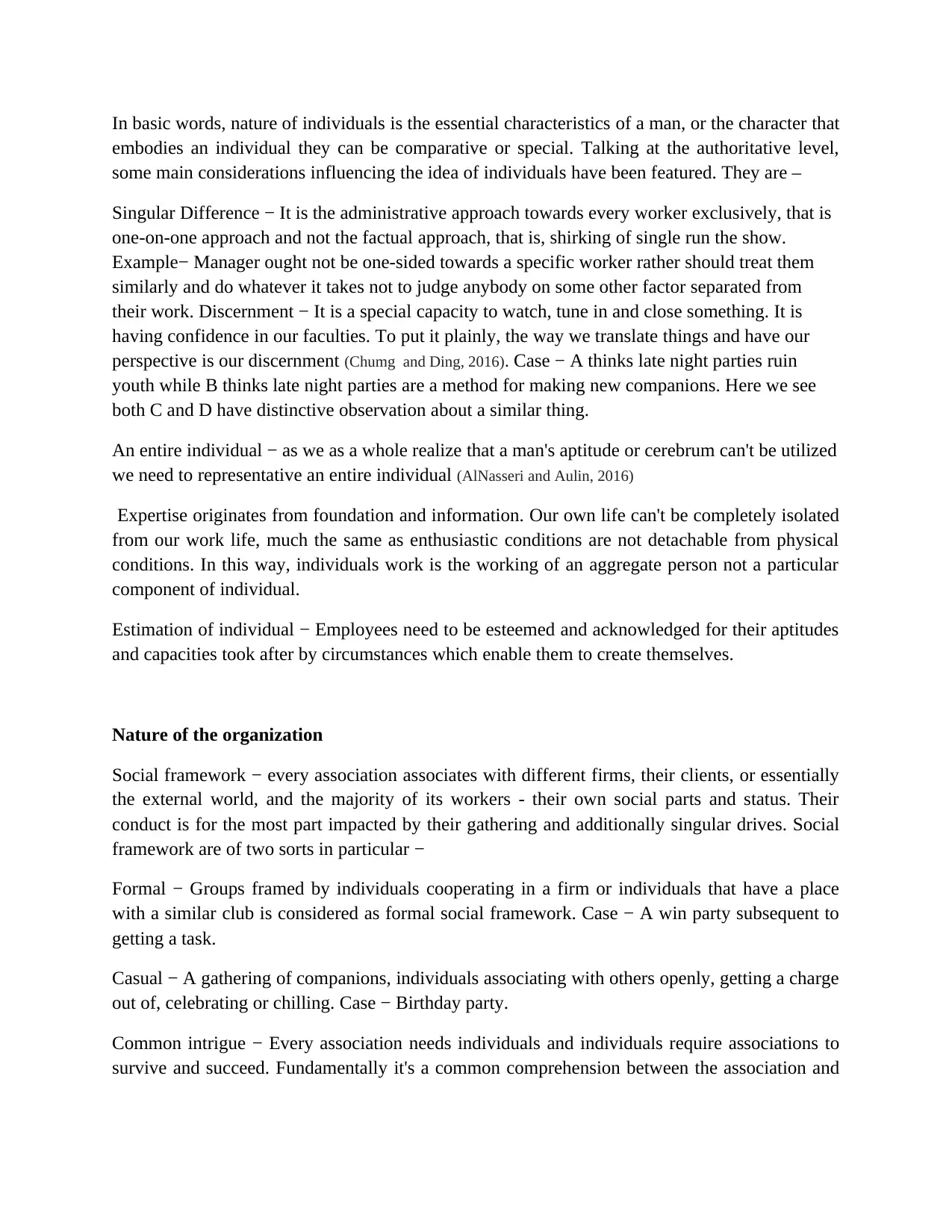
In basic words, nature of individuals is the essential characteristics of a man, or the character that
embodies an individual they can be comparative or special. Talking at the authoritative level,
some main considerations influencing the idea of individuals have been featured. They are –
Singular Difference − It is the administrative approach towards every worker exclusively, that is
one-on-one approach and not the factual approach, that is, shirking of single run the show.
Example− Manager ought not be one-sided towards a specific worker rather should treat them
similarly and do whatever it takes not to judge anybody on some other factor separated from
their work. Discernment − It is a special capacity to watch, tune in and close something. It is
having confidence in our faculties. To put it plainly, the way we translate things and have our
perspective is our discernment (Chumg and Ding, 2016). Case − A thinks late night parties ruin
youth while B thinks late night parties are a method for making new companions. Here we see
both C and D have distinctive observation about a similar thing.
An entire individual − as we as a whole realize that a man's aptitude or cerebrum can't be utilized
we need to representative an entire individual (AlNasseri and Aulin, 2016)
Expertise originates from foundation and information. Our own life can't be completely isolated
from our work life, much the same as enthusiastic conditions are not detachable from physical
conditions. In this way, individuals work is the working of an aggregate person not a particular
component of individual.
Estimation of individual − Employees need to be esteemed and acknowledged for their aptitudes
and capacities took after by circumstances which enable them to create themselves.
Nature of the organization
Social framework − every association associates with different firms, their clients, or essentially
the external world, and the majority of its workers - their own social parts and status. Their
conduct is for the most part impacted by their gathering and additionally singular drives. Social
framework are of two sorts in particular −
Formal − Groups framed by individuals cooperating in a firm or individuals that have a place
with a similar club is considered as formal social framework. Case − A win party subsequent to
getting a task.
Casual − A gathering of companions, individuals associating with others openly, getting a charge
out of, celebrating or chilling. Case − Birthday party.
Common intrigue − Every association needs individuals and individuals require associations to
survive and succeed. Fundamentally it's a common comprehension between the association and
embodies an individual they can be comparative or special. Talking at the authoritative level,
some main considerations influencing the idea of individuals have been featured. They are –
Singular Difference − It is the administrative approach towards every worker exclusively, that is
one-on-one approach and not the factual approach, that is, shirking of single run the show.
Example− Manager ought not be one-sided towards a specific worker rather should treat them
similarly and do whatever it takes not to judge anybody on some other factor separated from
their work. Discernment − It is a special capacity to watch, tune in and close something. It is
having confidence in our faculties. To put it plainly, the way we translate things and have our
perspective is our discernment (Chumg and Ding, 2016). Case − A thinks late night parties ruin
youth while B thinks late night parties are a method for making new companions. Here we see
both C and D have distinctive observation about a similar thing.
An entire individual − as we as a whole realize that a man's aptitude or cerebrum can't be utilized
we need to representative an entire individual (AlNasseri and Aulin, 2016)
Expertise originates from foundation and information. Our own life can't be completely isolated
from our work life, much the same as enthusiastic conditions are not detachable from physical
conditions. In this way, individuals work is the working of an aggregate person not a particular
component of individual.
Estimation of individual − Employees need to be esteemed and acknowledged for their aptitudes
and capacities took after by circumstances which enable them to create themselves.
Nature of the organization
Social framework − every association associates with different firms, their clients, or essentially
the external world, and the majority of its workers - their own social parts and status. Their
conduct is for the most part impacted by their gathering and additionally singular drives. Social
framework are of two sorts in particular −
Formal − Groups framed by individuals cooperating in a firm or individuals that have a place
with a similar club is considered as formal social framework. Case − A win party subsequent to
getting a task.
Casual − A gathering of companions, individuals associating with others openly, getting a charge
out of, celebrating or chilling. Case − Birthday party.
Common intrigue − Every association needs individuals and individuals require associations to
survive and succeed. Fundamentally it's a common comprehension between the association and
Paraphrase This Document
Need a fresh take? Get an instant paraphrase of this document with our AI Paraphraser
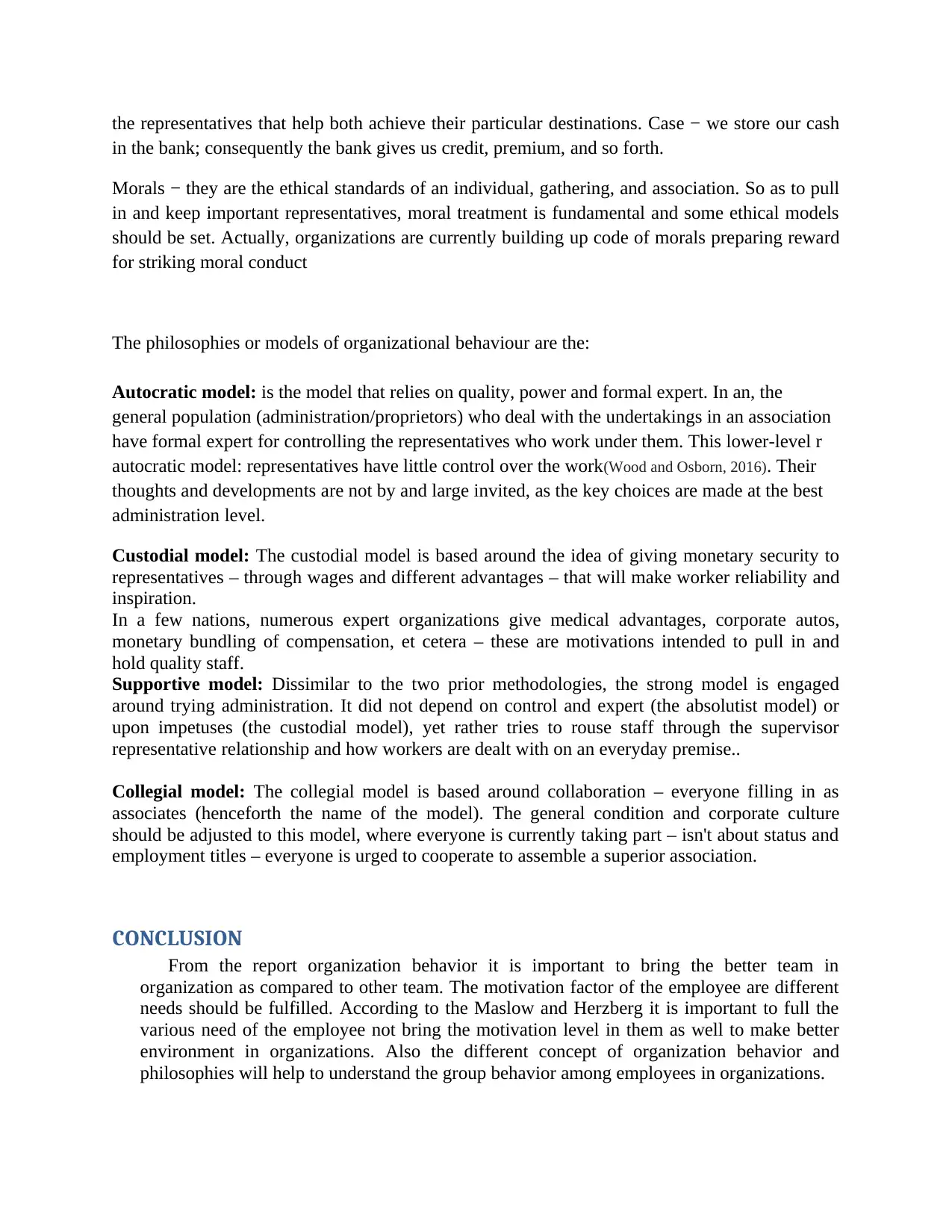
the representatives that help both achieve their particular destinations. Case − we store our cash
in the bank; consequently the bank gives us credit, premium, and so forth.
Morals − they are the ethical standards of an individual, gathering, and association. So as to pull
in and keep important representatives, moral treatment is fundamental and some ethical models
should be set. Actually, organizations are currently building up code of morals preparing reward
for striking moral conduct
The philosophies or models of organizational behaviour are the:
Autocratic model: is the model that relies on quality, power and formal expert. In an, the
general population (administration/proprietors) who deal with the undertakings in an association
have formal expert for controlling the representatives who work under them. This lower-level r
autocratic model: representatives have little control over the work(Wood and Osborn, 2016). Their
thoughts and developments are not by and large invited, as the key choices are made at the best
administration level.
Custodial model: The custodial model is based around the idea of giving monetary security to
representatives – through wages and different advantages – that will make worker reliability and
inspiration.
In a few nations, numerous expert organizations give medical advantages, corporate autos,
monetary bundling of compensation, et cetera – these are motivations intended to pull in and
hold quality staff.
Supportive model: Dissimilar to the two prior methodologies, the strong model is engaged
around trying administration. It did not depend on control and expert (the absolutist model) or
upon impetuses (the custodial model), yet rather tries to rouse staff through the supervisor
representative relationship and how workers are dealt with on an everyday premise..
Collegial model: The collegial model is based around collaboration – everyone filling in as
associates (henceforth the name of the model). The general condition and corporate culture
should be adjusted to this model, where everyone is currently taking part – isn't about status and
employment titles – everyone is urged to cooperate to assemble a superior association.
CONCLUSION
From the report organization behavior it is important to bring the better team in
organization as compared to other team. The motivation factor of the employee are different
needs should be fulfilled. According to the Maslow and Herzberg it is important to full the
various need of the employee not bring the motivation level in them as well to make better
environment in organizations. Also the different concept of organization behavior and
philosophies will help to understand the group behavior among employees in organizations.
in the bank; consequently the bank gives us credit, premium, and so forth.
Morals − they are the ethical standards of an individual, gathering, and association. So as to pull
in and keep important representatives, moral treatment is fundamental and some ethical models
should be set. Actually, organizations are currently building up code of morals preparing reward
for striking moral conduct
The philosophies or models of organizational behaviour are the:
Autocratic model: is the model that relies on quality, power and formal expert. In an, the
general population (administration/proprietors) who deal with the undertakings in an association
have formal expert for controlling the representatives who work under them. This lower-level r
autocratic model: representatives have little control over the work(Wood and Osborn, 2016). Their
thoughts and developments are not by and large invited, as the key choices are made at the best
administration level.
Custodial model: The custodial model is based around the idea of giving monetary security to
representatives – through wages and different advantages – that will make worker reliability and
inspiration.
In a few nations, numerous expert organizations give medical advantages, corporate autos,
monetary bundling of compensation, et cetera – these are motivations intended to pull in and
hold quality staff.
Supportive model: Dissimilar to the two prior methodologies, the strong model is engaged
around trying administration. It did not depend on control and expert (the absolutist model) or
upon impetuses (the custodial model), yet rather tries to rouse staff through the supervisor
representative relationship and how workers are dealt with on an everyday premise..
Collegial model: The collegial model is based around collaboration – everyone filling in as
associates (henceforth the name of the model). The general condition and corporate culture
should be adjusted to this model, where everyone is currently taking part – isn't about status and
employment titles – everyone is urged to cooperate to assemble a superior association.
CONCLUSION
From the report organization behavior it is important to bring the better team in
organization as compared to other team. The motivation factor of the employee are different
needs should be fulfilled. According to the Maslow and Herzberg it is important to full the
various need of the employee not bring the motivation level in them as well to make better
environment in organizations. Also the different concept of organization behavior and
philosophies will help to understand the group behavior among employees in organizations.

⊘ This is a preview!⊘
Do you want full access?
Subscribe today to unlock all pages.

Trusted by 1+ million students worldwide
1 out of 14
Related Documents
Your All-in-One AI-Powered Toolkit for Academic Success.
+13062052269
info@desklib.com
Available 24*7 on WhatsApp / Email
![[object Object]](/_next/static/media/star-bottom.7253800d.svg)
Unlock your academic potential
Copyright © 2020–2025 A2Z Services. All Rights Reserved. Developed and managed by ZUCOL.





